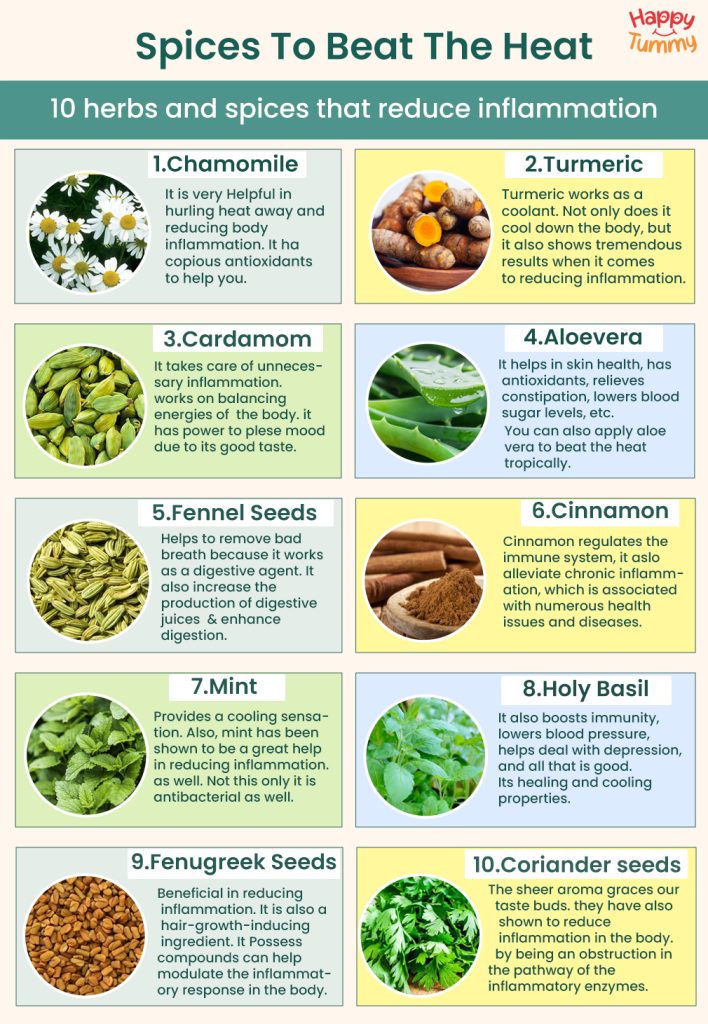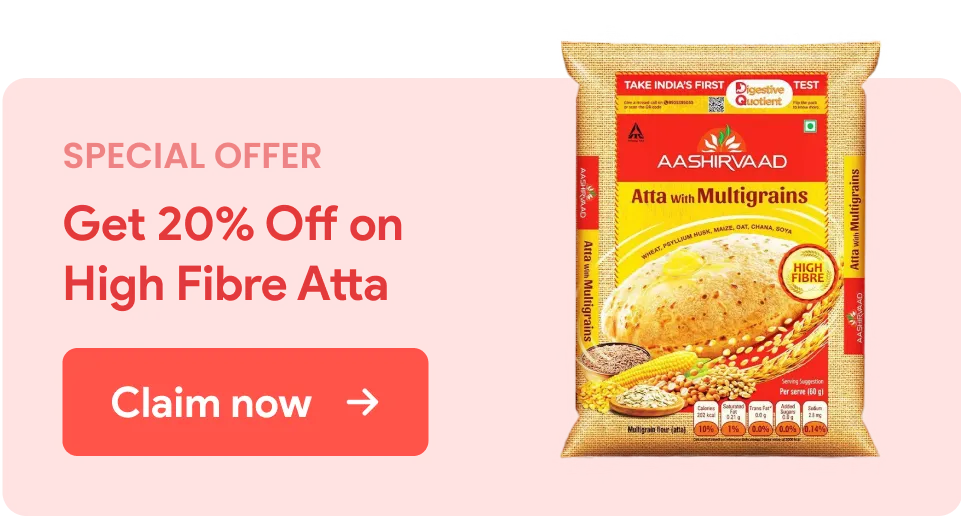Table of Contents
Are you tired of sweltering under the scorching sun, longing for a way to cool down and find relief from the oppressive heat?
As temperatures rise and the scorching heat becomes relentless, we all yearn for a refreshing respite. But what if I told you that there’s more to spices than just adding flavour to your dishes?
Picture this: you can harness the natural properties of aromatic spices and herbs to combat the heat and soothe your body from within.
Yes, you heard it right!
We are talking about inflammation.
Inflammation is a misjudged word. It is nothing but our bodies’ response to sickness. But the moment we hear it, our foreheads wrinkle up. And why not? It is not a good feeling at all.
In this blog, we dive into the world of anti-inflammatory and cooling spices and herbs that not only tantalize your taste buds but also offer a cool and calming relief during those sweltering summer days.
10 herbs and spices that reduce inflammation and help in cooling

Chronic inflammation invites numerous health issues. Pain, memory loss, compromised joint health, and whatnot come whamming. And this too during a heat wave? Brutal. So, the wisdom lies in taking haven at the feet of nature. And here is what grows in its embrace to grace us with coolness and relief:
1. Chamomile
Let’s start the list on a sweet floral note. Chamomile: a flowering plant that has been a beloved part of the ancient medicine culture.
Back in time, chamomile herb was used traditionally to treat several issues. Be it insomnia, anxiety, skin issues, or heat, chamomile was the answer to all. This cooling herb was a prime name in the dictionary of medicinal herbs. And it still holds the sceptre. [1]
Consuming chamomile regularly has shown to be helpful in hurling heat away and reducing body inflammation. Not only this, it has copious antioxidants to help you. So, how to consume? Brew it as tea, infuse flowers in your salad, or take chamomile oil.
To brew tea, steep 4-5 flowers in hot water for 5-10 minutes.
2. Turmeric
The pretty golden herb – Turmeric. For ages, this spice has been in the Indian culture. In ancient India, it was given many a name due to its numerous properties. In Sanskrit, it was called as Bhadra (auspicious), Haridra (Lord Krishna’s favourite), Kshamata (fat killer), Mehagni (fat killer), Vishagni (anti-poisonous), and whatnot.
Turmeric was given around 56 names in Sanskrit in ancient India.
Although many people think of turmeric as not to be a part of cooling spices, it sure is. When taken in the right amount, it works as a coolant. Not only does it cool down the body, but it also shows tremendous results when it comes to reducing inflammation.
How much turmeric to take per day? The recommended dosage is 500 mg to 2 grams.
You can consume it as turmeric milk or turmeric water but make sure that you use only high-quality turmeric like the Aashirvaad Turmeric powder that is authentic and unadulterated. Only by using a good quality turmeric, you can truly yield the power of this spice.
3. Cardamom
Brilliant cardamom — the source of all delectable and lip-smacking dishes. For ages, this sweet and aromatic spice has been making many an eye roll back in pleasure. Be it the sweet kheer, Indian tea, sharbat, or even thandai, not a single tongue it has disappointed. But did you know that cardamom, also known as elaichi, works on bringing a cool wave to the body?
Apart from cooling the body, cardamom also takes care of unnecessary inflammation. In Sanskrit, it is also known as ‘tridoshi’, which means that it works on balancing the energies of the body. Taking it regularly has shown beneficial results and a pleasing mood due to its good taste.
How much cardamom per day? Keep the number below 3 grams. You can add it your food in various forms, in your cooling drinks to enjoy its cooling benefits.
4. Mint
The moment we speak of summer, we speak of mint. It arrives like a cooling cloud overhead in the scorching summer. And the moment we put it inside our mouth, this cloud starts drizzling sweetly. This is why mint leaves provide a refreshing breeze to several cooling beverages like lemonade, mint cooler, etc. Sighs of bliss!
Menthol, the prime content in mint such as peppermint and spearmint, provides a cooling sensation. Also, mint has been shown to be a great help in reducing inflammation as well. Not only is it anti-inflammatory but antibacterial as well.
To get the maximum out of mint, consume 12-15 leaves daily.
You can make chutney or cool mint lemonade. Add it to your curries or just add it to your infused water.
For a detailed read on infused drinks, read here!
In ancient Greece, mint was used as a perfume, a breath freshener, and a medicinal herb.
5. Fennel Seeds
When we speak of delicious cooling spices, we speak of fennel seeds. These seeds have been a permanent aftertaste of Indian eating culture. You eat food and you finish it off with your mouth munching on a few fennel seeds. The reason behind this is not to remove bad breath but because it works as a digestive agent. Firstly, fennel seeds increase the production of digestive juices. These juices enhance digestion.
Fennel seeds are eaten because they cool down the body. Apart from it, these seeds possess anti-inflammatory properties and can help soothe inflammation in the digestive system. A wonderful item for digestive health.
So, how much fennel should you consume per day? Chew ½ or ¼ spoon twice a day after your meals.
Well, now you know the reason behind those mouth fresheners and condiments served after the big dinner containing fennel!
6. Coriander Seeds
Green has always meant good times.
And when this green garnishes dishes in the form of coriander, the sheer aroma graces our taste buds with some otherworldly taste, refreshment, and coolness. And as cool are coriander leaves, as cool are its seeds.
Coriander seeds, not only are these seeds refreshing, but they have also shown to reduce inflammation in the body. It works toward this by being an obstruction in the pathway of inflammatory enzymes.
You may either use coriander seeds in making dishes or prepare coriander water. For the latter, soak 1 tablespoon seeds in 1 glass of water overnight.
As Chef Ranveer Brar says, “ Dhaniya thok k daalo!”
You can actually be doing it to beat the heat and inflammation.
7. Aloe Vera
Nature’s medicinal chest is never complete without Aloe Vera. It is its soul. Visit a cosmetic shop or pharmacy and you’ll find products loaded with this alluring herb. Why? Because it works. And that it works well.
Aloe Vera is a succulent plant that has a gel-like paste inside its leaves. This is where the nectar lies. This gel is rich in numerous medicinal properties including anti-inflammatory properties. Apart from it, it helps in skin health, has antioxidants, relieves constipation, lowers blood sugar levels, etc.
How should you consume Aloe Vera? The best way is to take it orally. We know, it tastes bad. To counter it, you may simply make it a part of your smoothies. Up to 250 ml per day is a good number.
Apart from consumption, you can also apply aloe vera to beat the heat tropically. Aloe is a coolant that soothes your skin, helps heal sunburn, and gives it a radiant glow.
8. Fenugreek Seeds
Another compulsory ingredient of the Indian spice box. Although it is mainly known as a hair-growth-inducing ingredient, it also serves many other purposes. Consuming Fenugreek seeds on a daily basis has been shown to be beneficial in reducing inflammation.
Fenugreek seeds contain various bioactive compounds. Flavonoids, alkaloids, and saponins, all these compounds possess anti-inflammatory properties. These compounds can help modulate the inflammatory response in the body.
Now, about the dosage – Just like all other cooling spices, its consumption must be limited too. Take anywhere around 5-10 grams per day. Not more.
9. Holy Basil
Holy Basil, also known as Tulsi, is a plant that is revered throughout India. And when we understand the depth of its healing properties, we see why it is revered.
Firstly, basil has both anti-inflammatory and cooling properties. This makes it a great summer addition. And apart from these properties, it also boosts immunity, lowers blood pressure, helps deal with depression, and all that is good. It surely must have buzzed your ears with its name during the cruel Covid times. Back then, you easily must have hogged on these leaves to gain some extra strength. Don’t do it now.
Keep the consumption of basil leaves around 6 to 10 leaves per day.
In Hinduism, Holy Basil is believed to be a manifestation of Goddess Tulasi.
10. Cinnamon
Beyond its delightful taste and aroma, cinnamon offers an array of health benefits, particularly as an effective anti-inflammatory spice. This versatile spice contains various compounds, including cinnamaldehyde, which is responsible for its unique flavour and scent.
This cinnamaldehyde also acts as a potent antioxidant, playing a crucial role in combating oxidative stress and reducing inflammation in the body.
Studies have revealed that cinnamon possesses the ability to inhibit the production of inflammatory substances, such as cytokines and certain enzymes. By regulating the immune response, cinnamon helps to alleviate chronic inflammation, which is associated with numerous health issues and diseases. [2]
To enjoy the benefits of cinnamon, try sprinkling it on your oatmeal, adding it to your baking, or stirring it into warm drinks. The ideal amount of cinnamon for a day would be to take ½ to 1 teaspoon.
Conclusion
Mother Nature offers us numerous herbs and spices that help us defend ourselves from different health issues. We find mint, basil, fenugreek, fennel, turmeric, cardamom, and numerous other food ingredients doing wonders for different bodily problems.
Not only do these herbs and spices provide a cool breeze of relief from heat and inflammation, but they also serve numerous other benefits. You ask for antioxidants, they have it. Weight loss properties? They have it. Immunity strengthening spell? Again, they have it.
Fabulous and friendly they are, but not when overly consumed. This is why you must always consume these below the limits. Also, you must consult your dietician or doctor before making them a regular part of your diet, especially if you are under some medications.
So, let these cooling spices and herbs be your allies this summer. Cheers to a cool and inflammation-free season, spiced with pure bliss!
FAQs
Inflammation is a natural response of the immune system to protect the body from injury, infection, or harmful substances. It is characterized by redness, swelling, warmth, pain, and sometimes loss of function in the affected area. While acute inflammation is a crucial part of the body’s healing process, chronic inflammation can contribute to various health conditions.
Several foods have anti-inflammatory properties that can help reduce inflammation in the body.
Fatty fish: Rich in omega-3 fatty acids, fish like salmon, mackerel, and sardines have been shown to help reduce inflammation.
Berries: Blueberries, strawberries, and other brightly coloured berries contain antioxidants and compounds that have anti-inflammatory effects.
Leafy greens: Vegetables like spinach, kale, and collard greens are packed with nutrients, including vitamins, minerals, and antioxidants that can combat inflammation.
While there is no specific drink that can “kill” inflammation, certain beverages are known to possess anti-inflammatory properties like Green tea and Turmeric tea.
Which fruits are anti-inflammatory?
Berries like blueberries, strawberries, raspberries, and blackberries; pineapple, and citrus fruits like orange, lemon, and grapefruit have anti-inflammatory properties due to their high content of antioxidants and phytochemicals.















